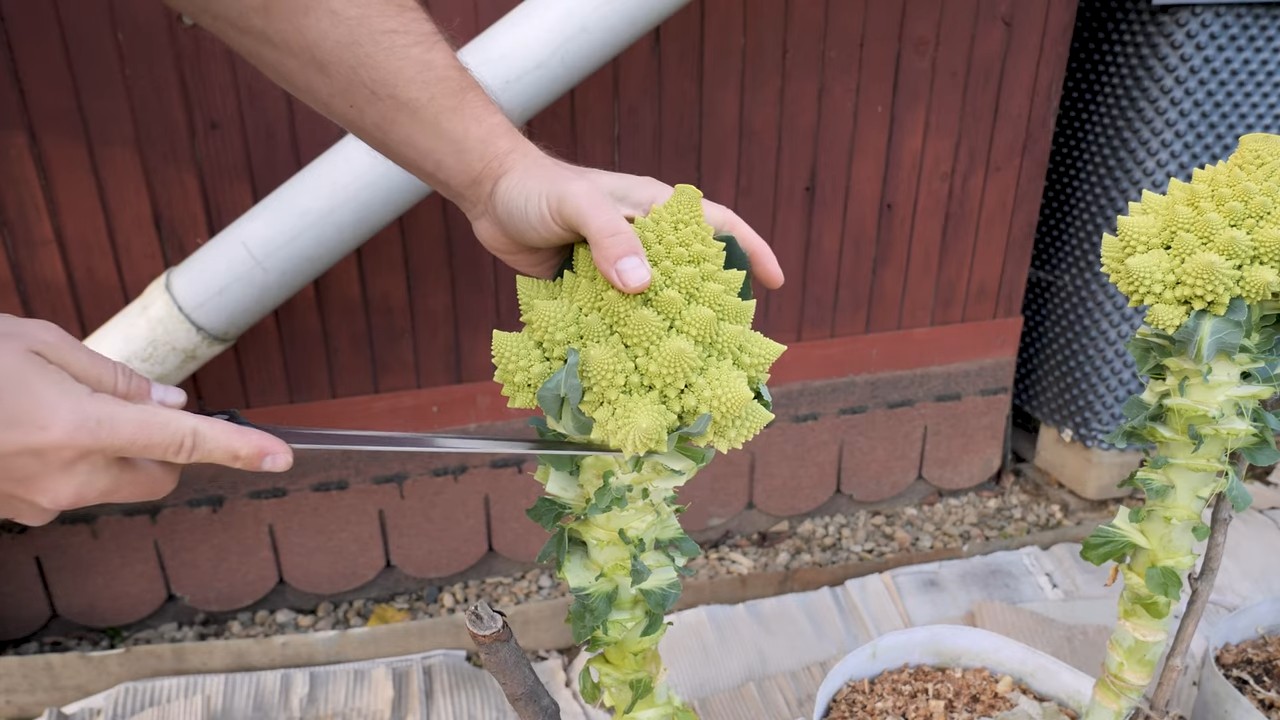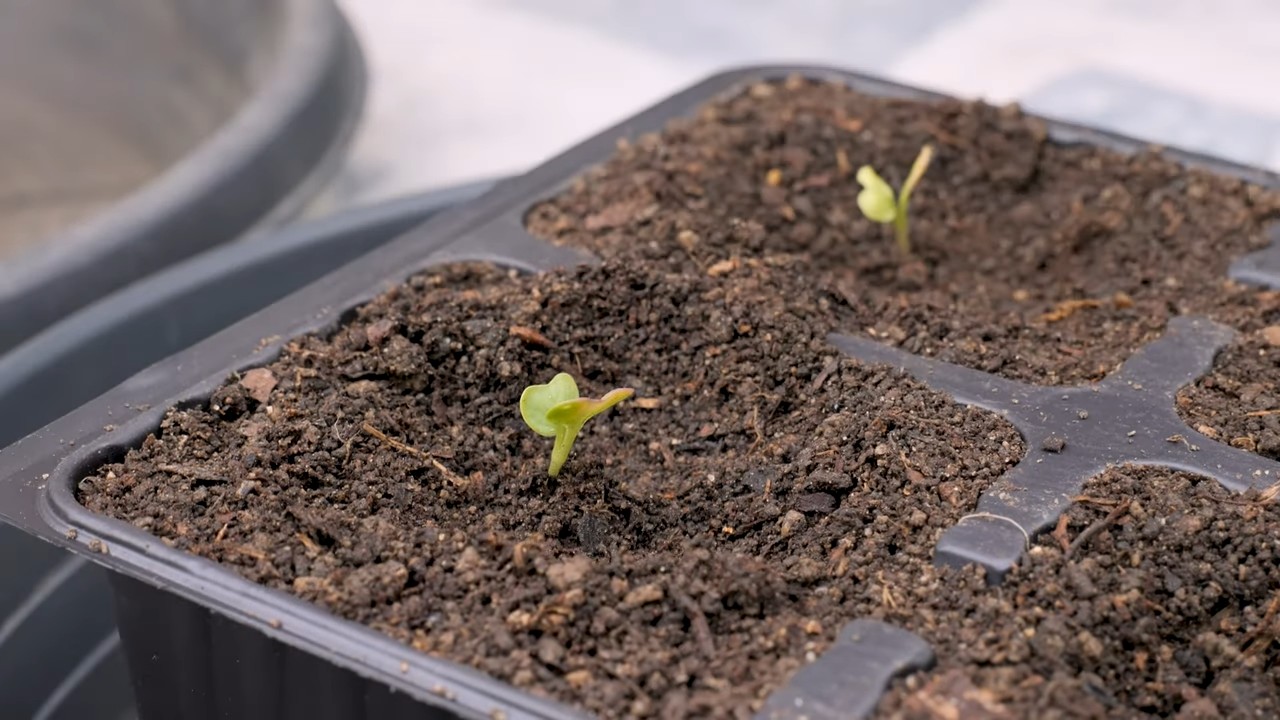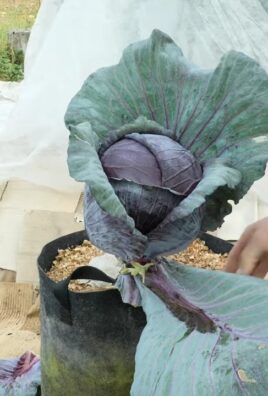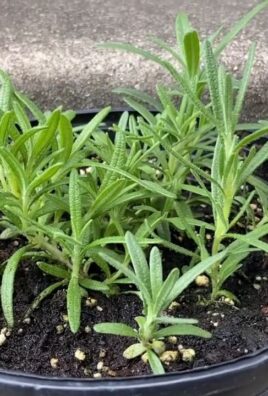Container gardening Romanesco cauliflower might sound intimidating, but trust me, it’s a rewarding and surprisingly simple project! Have you ever dreamed of harvesting your own vibrant, fractal-patterned Romanesco right from your patio or balcony? Imagine the satisfaction of serving a dish featuring this unique vegetable, knowing you nurtured it from seed to table. This isn’t just about growing food; it’s about connecting with nature, even in the smallest of spaces.
While Romanesco cauliflower isn’t steeped in ancient history like some other vegetables, its relatively recent development in Italy showcases the power of selective breeding and human ingenuity. It’s a testament to our ability to shape nature to create something truly extraordinary. For centuries, gardening has been a way for people to connect with the earth, provide for their families, and find solace in the natural world. Now, even with limited space, we can continue this tradition.
Many people shy away from growing vegetables, especially unique ones like Romanesco, thinking it requires vast gardens and expert knowledge. But that’s simply not true! This DIY guide will break down the process of container gardening Romanesco cauliflower into easy-to-follow steps, offering tips and tricks to ensure your success. We’ll cover everything from choosing the right container and soil to providing the necessary sunlight and nutrients. So, ditch the grocery store produce aisle and get ready to experience the joy of growing your own beautiful and delicious Romanesco cauliflower!

Container Gardening: Growing Romanesco Cauliflower Like a Pro!
Okay, so you want to grow Romanesco cauliflower in a container? Awesome! It’s totally doable, and honestly, there’s nothing quite like harvesting your own funky-looking, delicious Romanesco. I’ve done it, and I’m here to share all my secrets (well, not *all* of them, but most!). This guide will walk you through everything from choosing the right container to dealing with pesky pests. Let’s get growing!
Choosing the Right Container and Soil
Before we even think about seeds, let’s talk about where our Romanesco will be living. This is crucial for success!
* Container Size: Romanesco needs space! Aim for a container that’s at least 18 inches in diameter and 18 inches deep. A 5-gallon bucket is a good starting point, but bigger is generally better. Think of it this way: happy roots, happy plant!
* Drainage: This is non-negotiable. Make sure your container has plenty of drainage holes. Romanesco hates soggy feet! If your container doesn’t have enough, drill some more.
* Material: Plastic, terracotta, even fabric pots will work. Just keep in mind that terracotta dries out faster, so you’ll need to water more frequently. Dark-colored containers can also get hotter in direct sunlight, which isn’t ideal.
* Soil: Forget garden soil! It’s too heavy and compacts easily. You need a well-draining potting mix. I like to use a mix of:
* Compost (for nutrients and moisture retention)
* Peat moss or coco coir (for drainage and aeration)
* Perlite or vermiculite (for even more drainage)
You can buy a pre-made potting mix, but honestly, mixing your own is cheaper and you have more control over the ingredients. I usually aim for a mix that’s about 1/3 compost, 1/3 peat moss/coco coir, and 1/3 perlite/vermiculite.
Starting Your Romanesco Seeds (or Buying Transplants)
You have two options here: start your own seeds or buy transplants from a nursery. Starting from seed is cheaper and gives you more control, but it requires a little more effort.
* Starting Seeds Indoors (Recommended):
* Start your seeds about 4-6 weeks before the last expected frost in your area.
* Use seed starting trays or small pots filled with seed starting mix (a finer version of potting mix).
* Sow the seeds about 1/4 inch deep.
* Keep the soil consistently moist but not soggy.
* Provide plenty of light! A sunny windowsill might not be enough. I recommend using grow lights.
* Once the seedlings have a few sets of true leaves, you can transplant them into larger pots.
* Buying Transplants:
* Look for healthy-looking plants with sturdy stems and no signs of pests or diseases.
* Choose plants that are not root-bound (roots circling tightly around the bottom of the pot).
* Harden off the transplants before planting them in your container. This means gradually exposing them to outdoor conditions over a week or so.
Planting Your Romanesco
Alright, time to get those plants in their new home!
1. Prepare the Container: Fill your container with your chosen potting mix, leaving a few inches of space at the top.
2. Dig a Hole: Dig a hole in the center of the container that’s large enough to accommodate the root ball of your seedling or transplant.
3. Plant the Romanesco: Gently remove the seedling or transplant from its pot and place it in the hole. Make sure the top of the root ball is level with the soil surface.
4. Backfill with Soil: Fill in the hole with potting mix and gently firm the soil around the plant.
5. Water Thoroughly: Water the plant well after planting. This helps settle the soil and gets the roots off to a good start.
Caring for Your Romanesco
This is where the real work begins! Romanesco needs consistent care to thrive.
* Watering: Romanesco needs consistent moisture, especially during hot weather. Water deeply whenever the top inch of soil feels dry to the touch. Avoid overhead watering, as this can lead to fungal diseases.
* Fertilizing: Romanesco is a heavy feeder. Fertilize every 2-3 weeks with a balanced liquid fertilizer. You can also amend the soil with compost tea.
* Sunlight: Romanesco needs at least 6 hours of sunlight per day. If you don’t have a sunny spot, you may need to supplement with grow lights.
* Temperature: Romanesco prefers cool weather. The ideal temperature range is 60-70°F (15-21°C). If temperatures get too hot, the heads may bolt (flower prematurely).
* Pest Control: Keep an eye out for common pests like aphids, cabbage worms, and flea beetles. I’ll cover pest control in more detail below.
* Weed Control: Keep the container free of weeds. Weeds compete with your Romanesco for nutrients and water.
Dealing with Pests and Diseases
Pests and diseases can be a real pain, but don’t worry, there are things you can do to prevent and control them.
* Aphids: These tiny sap-sucking insects can weaken your plants. You can control them with a strong spray of water, insecticidal soap, or neem oil.
* Cabbage Worms: These green caterpillars can devour your Romanesco leaves. Handpicking them off the plants is the most effective method. You can also use Bacillus thuringiensis (Bt), a natural insecticide.
* Flea Beetles: These tiny jumping beetles can create small holes in the leaves. Cover your plants with row covers to prevent them from reaching the plants. You can also use insecticidal soap or neem oil.
* Clubroot: This fungal disease causes the roots to swell and distort. Prevent clubroot by ensuring good drainage and avoiding planting brassicas (like cauliflower, broccoli, and cabbage) in the same container year after year.
* Black Rot: This bacterial disease causes black spots on the leaves and can eventually kill the plant. Prevent black rot by avoiding overhead watering and ensuring good air circulation.
Harvesting Your Romanesco
The moment you’ve been waiting for!
* Timing: Romanesco is typically ready to harvest about 75-85 days after transplanting. The head should be firm and compact, and the florets should be tightly closed.
* How to Harvest: Use a sharp knife to cut the head from the plant, leaving a few inches of stem attached.
* Storage: Store your Romanesco in the refrigerator for up to a week.
Troubleshooting
Sometimes things don’t go as planned. Here are some common problems and how to fix them:
* Yellowing Leaves: This could be a sign of nutrient deficiency, overwatering, or underwatering. Check the soil moisture and fertilize if necessary.
* Bolting (Premature Flowering): This is usually caused by hot weather or stress. Try to provide shade during the hottest part of the day.
* Small Heads: This could be a sign of nutrient deficiency, lack of sunlight, or overcrowding. Make sure your plants are getting enough fertilizer and sunlight, and thin them out if necessary.
* No Heads Forming: This could be a sign of poor soil, lack of sunlight, or pests. Amend the soil with compost, provide plenty of sunlight, and control pests.
Extra Tips for Success
* Succession Planting: Plant new Romanesco seedlings every few weeks to extend your harvest season.
* Companion Planting: Plant Romanesco with companion plants like marigolds, nasturtiums, and herbs to deter pests.
* Record Keeping: Keep a record of your planting dates, fertilizer applications, and pest control measures. This will help you learn from your mistakes and improve your results next year.
* Don’t Give Up! Gardening can be challenging, but it’s also incredibly rewarding. Don’t be discouraged if you don’t get it right the first time. Just keep learning and experimenting, and you’ll eventually get the hang of it.
Growing Romanesco cauliflower in a container is a fun and rewarding experience. With a little bit of planning and effort, you can enjoy fresh, homegrown Romanesco all season long. Happy gardening!

Conclusion
So, there you have it! Growing your own Romanesco cauliflower in containers is not only achievable but also incredibly rewarding. Forget the exorbitant prices at the grocery store and the disappointment of finding less-than-fresh produce. With a little planning and effort, you can cultivate these stunning, fractal vegetables right on your patio, balcony, or even a sunny windowsill.
This DIY trick is a must-try for several reasons. First, it puts you in control of the entire growing process, ensuring that your Romanesco is free from harmful pesticides and herbicides. You know exactly what goes into your food, from the soil to the fertilizer. Second, it’s a fantastic way to connect with nature and experience the satisfaction of nurturing something from seed to harvest. There’s nothing quite like the feeling of pulling a perfectly formed Romanesco head from your container, knowing you grew it yourself. Third, container gardening makes growing Romanesco accessible to everyone, regardless of the size of their property. Even if you only have a small space, you can still enjoy the unique flavor and beauty of this remarkable vegetable.
But the benefits don’t stop there. Growing your own Romanesco cauliflower in containers allows for experimentation and customization. Want to try a different variety? Go for it! There are several Romanesco cultivars available, each with its own subtle nuances in flavor and appearance. You can also experiment with different soil mixes, fertilizers, and companion plants to optimize your growing conditions and maximize your yield. Consider adding marigolds to your containers to deter pests, or basil to improve the flavor of your Romanesco.
For a spicier kick, try adding a pinch of cayenne pepper to your soil mix. This can help deter pests and add a subtle heat to your Romanesco. If you prefer a sweeter flavor, consider adding a small amount of molasses to your watering can every few weeks. This will provide your plants with extra nutrients and enhance the natural sweetness of the Romanesco.
Don’t be afraid to get creative and tailor your container gardening approach to your specific needs and preferences. The possibilities are endless!
We strongly encourage you to give this DIY trick a try. It’s a fun, educational, and ultimately delicious experience. And once you’ve harvested your first Romanesco, be sure to share your success with us! Post photos of your container gardens and your culinary creations on social media using #ContainerRomanesco or tag us in your posts. We’d love to see what you’re growing and how you’re enjoying your homegrown Romanesco cauliflower.
Growing Romanesco cauliflower in containers is more than just a gardening project; it’s a journey of discovery, a celebration of nature, and a testament to the power of DIY. So, grab your seeds, your containers, and your gardening gloves, and get ready to embark on a rewarding adventure. You won’t regret it!
Frequently Asked Questions (FAQ)
What size container do I need for growing Romanesco cauliflower?
A: Romanesco cauliflower needs a fairly large container to accommodate its root system and support its growth. A container that is at least 12 inches in diameter and 12 inches deep is recommended. Larger is always better, so if you have the space, a 15-gallon container or larger would be ideal. This will provide ample room for the roots to spread and allow the plant to reach its full potential. Make sure the container has drainage holes to prevent waterlogging, which can lead to root rot.
What kind of soil should I use for container gardening Romanesco cauliflower?
A: Romanesco cauliflower thrives in well-draining, nutrient-rich soil. A good potting mix specifically formulated for vegetables is a great starting point. You can also amend your potting mix with compost, aged manure, or other organic matter to improve its fertility and drainage. Aim for a slightly acidic to neutral pH level (around 6.0 to 7.0). Avoid using garden soil in containers, as it can become compacted and doesn’t drain well.
How often should I water my container-grown Romanesco cauliflower?
A: Romanesco cauliflower needs consistent moisture, especially during hot weather. Water deeply whenever the top inch of soil feels dry to the touch. Avoid overwatering, as this can lead to root rot. Check the soil moisture regularly and adjust your watering schedule accordingly. During periods of heavy rain, you may need to reduce watering frequency. A good rule of thumb is to water thoroughly in the morning so the leaves have time to dry before nightfall, which can help prevent fungal diseases.
What kind of fertilizer should I use for Romanesco cauliflower?
A: Romanesco cauliflower is a heavy feeder and requires regular fertilization to produce a healthy head. Use a balanced fertilizer with equal amounts of nitrogen, phosphorus, and potassium (e.g., 10-10-10) or a fertilizer specifically formulated for vegetables. Follow the instructions on the fertilizer package for application rates. You can also supplement with organic fertilizers like compost tea or fish emulsion. Fertilize every 2-3 weeks during the growing season.
How much sunlight does Romanesco cauliflower need?
A: Romanesco cauliflower needs at least 6 hours of direct sunlight per day to thrive. Choose a location for your container garden that receives plenty of sunlight. If you live in a hot climate, provide some afternoon shade to prevent the plants from overheating. If you don’t have enough natural sunlight, you can supplement with grow lights.
How long does it take to grow Romanesco cauliflower in containers?
A: Romanesco cauliflower typically takes 75-90 days to mature from transplant. Start seeds indoors 6-8 weeks before the last expected frost. Transplant seedlings into containers after the danger of frost has passed. Keep in mind that growing times can vary depending on the variety, climate, and growing conditions.
What are some common pests and diseases that affect Romanesco cauliflower?
A: Common pests that affect Romanesco cauliflower include aphids, cabbage worms, and flea beetles. Diseases include clubroot, black rot, and downy mildew. Inspect your plants regularly for signs of pests or diseases. Use organic pest control methods like insecticidal soap or neem oil to control pests. Ensure good air circulation and avoid overwatering to prevent diseases. If you encounter clubroot, amend the soil with lime to raise the pH.
Can I grow Romanesco cauliflower in containers during the winter?
A: In mild climates, you may be able to grow Romanesco cauliflower in containers during the winter. Choose a variety that is suitable for cool-season growing. Provide protection from frost and freezing temperatures. In colder climates, you can grow Romanesco cauliflower indoors under grow lights.
How do I know when my Romanesco cauliflower is ready to harvest?
A: Romanesco cauliflower is ready to harvest when the head is firm, compact, and has reached the desired size. The florets should be tightly packed together and the head should be free from blemishes or discoloration. Use a sharp knife to cut the head from the plant, leaving a few leaves attached.
Can I save seeds from my container-grown Romanesco cauliflower?
A: Saving seeds from Romanesco cauliflower can be challenging, as it is a biennial plant, meaning it typically flowers and produces seeds in its second year. To save seeds, you would need to overwinter the plant and allow it to flower the following spring. However, Romanesco cauliflower is often cross-pollinated, so the seeds may not produce true-to-type plants. For best results, purchase seeds from a reputable source each year.




Leave a Comment